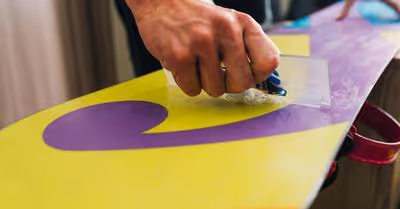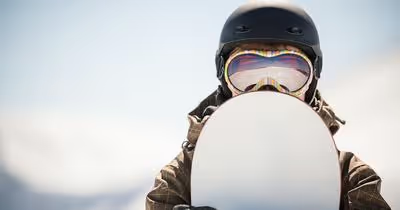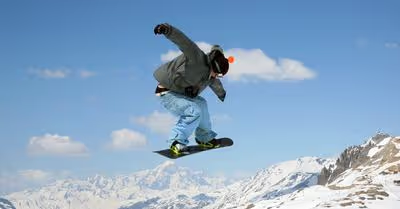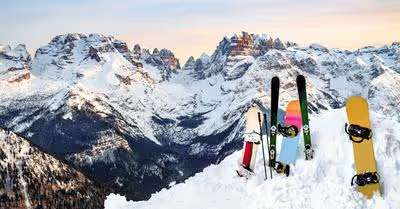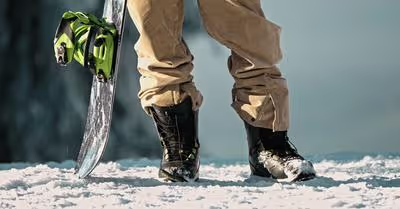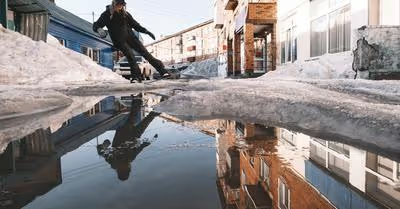Table of Contents
Basics of Snowboarding and Skateboarding
As someone who's experienced both snowboarding and skateboarding, I understand that each sport is unique and has its own set of challenges.
Snowboarding is generally harder to master than skateboarding. To learn snowboarding, you should master specific skills like controlling the board, changing direction, and riding downhill, which can be challenging for beginners.
On the other hand, skateboarding tends to be more intuitive once you grasp basic riding skills, such as balancing and steering.
Let's dive into the subtle intricacies of snowboarding and skateboarding, helping you grasp and appreciate both sports even more.
Riding Skills
When it comes to riding skills, snowboarding and skateboarding share some similarities, such as the role of natural balance. However, key differences lie in how the boards' characteristics affect the overall riding experience.
For example, skateboarding has four wheels on the ground, which allows for stability and easy maneuvering. Conversely, snowboarding relies on edge riding and using the board's edge for control.
Essential Equipment for Snowboarding and Skateboarding
Equipment plays a critical role in both sports. The most significant contrast between snowboarding and skateboarding gear is the binding mechanism.
Snowboards have bindings that securely strap the rider's feet onto the board, limiting the possibility of performing flips, unlike skateboards.
Skateboards, however, do not have any binding mechanism - the rider's feet are free to move and manipulate the board during tricks and flips. Check out this video for more information about snowboarding and skateboarding.
Comparison of Tricks
Snowboarding and skateboarding tricks differ fundamentally in execution, primarily due to their distinct terrains and equipment. While snowboarding is practiced on snow-covered slopes with a board strapped to your feet, skateboarding typically takes place on concrete surfaces with a wheeled board.
This substantial contrast has a significant impact on the tricks that can be performed in each sport.
In snowboarding, many beginner tricks involve learning essential skills like turns, carving, and simple jumps. Progressing into intermediate and advanced territory, you'll start encountering a variety of rail tricks, spins, flips, and grabs.
A crucial aspect of mastering snowboarding tricks is understanding how to use the natural features of the mountain landscape or man-made elements like half-pipes and big air jumps to your advantage.
Skateboarding tricks, on the other hand, are performed on a more extensive range of terrain, including streets, skate parks, and ramps. As a skateboarder, the first trick you'll learn is the ollie, an essential foundational technique that enables you to jump and land smoothly.
The ollie is the basis for many more advanced skateboarding tricks, such as flips, grinds, and slides. Skateboarders also perform rail tricks, utilizing ledges, handrails, and curbs for a wide range of complex and creative maneuvers.
While the environments and equipment of snowboarding and skateboarding are different, there are instances where the sports' tricks overlap. Both snowboarding and skateboarding have their unique versions of spins, flips, and rail tricks.
The fundamental concepts such as maintaining balance, precise timing, and body movement are shared between these two board sports.
Snowboarding and Skateboarding Skills Transfer
Skateboarding and snowboarding share a key skill: balance. The ability to maintain one's balance while riding a board translates well between the sports.
However, there are also significant differences in their learning curves, which can make transferring skills from one sport to the other a challenging endeavor.
Snowboarding has a more gradual learning curve, allowing beginners to get the hang of things without too many harsh falls. Conversely, skateboarding has a steeper learning curve, and each misstep can lead to a painful fall.
While practicing both sports will undoubtedly help to improve your balancing skills, it is essential to adapt your technique for each sport's unique riding style and environment.
For instance, snowboarding involves bindings for your feet, while skateboarding doesn't, requiring modifications in your foot positioning.
Additionally, the skill improvement curve in snowboarding versus skateboarding differs. Progressing in snowboarding may be quicker due to a less steep learning curve.
Skateboarding, on the other hand, can take more time and practice to reach higher levels of proficiency due to its more challenging beginning stages.
Seasonal and Geographical Differences
As a snowboarder and skateboarder, I realized that one of the most significant differences between these two sports lies in their seasonal and geographical aspects. Snowboarding season is primarily during the winter months, while skateboarding is more of an all-year-round activity.
Snowboarding: The winter wonderland experience. Riding a snowboard requires snow and typically takes place at ski resorts, where you'll need to purchase lift tickets.
The snowboarding season varies depending on the location but is generally from late November to early April. Slippery conditions like snow and ice make snowboarding a colder and more challenging pursuit compared to skateboarding.
Skateboarding: Anytime, anyplace. Unlike its winter counterpart, skateboarding can be enjoyed throughout the year as long as the weather permits. You don't need a specific location like a ski resort, and there are no lift ticket expenses involved, making skateboarding highly accessible for enthusiasts.
Keep in mind that slippery conditions, such as rain or ice, can make skateboarding harder and unsafe, so remember to put your safety first.
Snowboarding vs. Skateboarding: The Big Difference
I've had the pleasure of experiencing both snowboarding and skateboarding. While they share many similarities and have influenced each other in various ways, there are some key differences between the two sports that are worth discussing. Watch this video to understand the key differences between snowboarding and skateboarding.
The following table shows the major differences between snowboarding and skateboarding:
The Physicality of Snowboarding and Skateboarding
As an avid sports enthusiast, I've always been excited by the physical challenges of snowboarding and skateboarding. Let’s dive into the unique aspects of each sport and examine how your front foot, balance, upper body, and stance come into play on hard surfaces like concrete and snow.
The biggest difference between snowboarding and skateboarding lies in the position of your front foot. In snowboarding, your feet are strapped into bindings, and you'll often lean forward with your front foot leading to engage your edge.
Conversely, in skateboarding, your front foot is typically placed near the middle of the board, providing the necessary balance to shift your weight and maneuver the board on concrete.
When it comes to balance, both sports require a strong sense of equilibrium. Snowboarding requires you to maintain your balance on the edge of your board as you glide down the slope, while skateboarding requires the ability to shift your weight and balance on the four small wheels underneath your board.
The constant adjustments to different terrain, speeds, and conditions in both sports will test and develop your balance over time.
The role of your upper body in these sports is also significant. In snowboarding, your upper body is primarily used to help steer and control the board, whereas in skateboarding, your arms and shoulders play a critical role in performing tricks like ollies, flips, and grinds.
Additionally, the upper body strength needed for riding a skateboard tends to involve more explosive movements, while snowboarding requires sustained muscular effort, especially in the core and legs.
Sports Equipment and Requirements
Now, we'll compare and contrast the gear and skills necessary for each activity, giving you a clearer picture of what to expect when you hit the slopes or park with a snowboard or skateboard.
Snowboarding necessitates a snowboard, snowboard boots, bindings, winter clothing, and other protective gear such as a helmet, goggles, and gloves.
One key difference between snowboarding and skateboarding is the terrain - you need snow-covered slopes for fun and enjoyable snowboarding, which might not be available everywhere or year-round.
Moreover, the snowboard has sharp steel edges for grip on snow, and your feet are strapped in, allowing for better control during turns and tricks.
Skateboarding, on the other hand, requires a wooden skateboard with wheels, often accompanied by safety gear like a helmet, elbow pads, and knee pads. Skateboarding can be done on various surfaces, such as streets, skate parks, or ramps, making it more accessible and versatile than snowboarding.
You can ride different types of skateboards, like a standard skateboard, longboard, or cruiser, based on your style and preferences. Unlike snowboarding, your feet aren't strapped in, giving you more freedom to perform tricks and jumps.
In terms of skill requirements, both sports share a similar stance, with your legs shoulder-width apart and knees slightly bent for balance.
Cultural Impact: Snowboarding vs. Skateboarding Communities
When I think about snowboarding and skateboarding, two distinct communities and cultures come to mind. While these sports share some similarities, such as their use of a board to perform various tricks, their cultural impacts and communities are unique from each other.
Snowboarding has made a significant impact on mountain towns, fostering a culture centered around the appreciation of nature, preserving the environment, and encouraging camaraderie among people who love snowboarding.
On the other hand, skateboarding finds its roots in urban culture, where it has played a crucial role in developing street art and various subcultures.
Also, snowboarding is more closely linked to the winter season, mountain settings, and environmentally conscious attitudes. The snowboarding community emphasizes efforts like "Leave No Trace" and maintains a strong sense of community and comradeship among riders.
In contrast, skateboarding originates in the streets, parks, and urban landscapes. The sport has given rise to various artistic expressions, such as street art and design and alternative subcultures that have helped shape popular culture.
A study from the Pullias Center for Higher Education reveals that skateboarding encourages mental health benefits, fosters community, and promotes diversity and resilience. Moreover, factors like gender and race play a significant role in the skateboarding community.
Recent Articles



